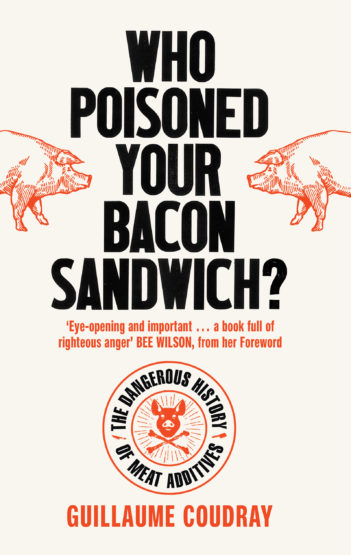Remarkably there has never been a book about the processed meat industry and the cancer risk it poses to consumers.
Until now.
French film maker Guillaume Coudray is just out with – Who Poisoned Your Bacon Sandwich? (Icon Books, 2021) – a detailed investigative report into the use of nitro-additives in meat.
Coudray reports that most mass-produced processed meats on the market in the United States – and now even many artisanal products – contain chemicals like nitrates and nitrites that react with meat to form cancer-causing compounds.
Since the 1970s, the meat-processing industry has denied the health risks because these additives make curing cheaper and quicker, extending shelf life and giving meat a pleasing pink color.
Coudray says that in fact these additives are unnecessary.
The world famous Parma ham from Italy has not contained these additives for nearly 30 years. And indeed all traditional cured meats were once produced without them.
“Will the consumer go on buying chemically treated meats?” Coudray asks. “In the age of social media, it will become more and more difficult to hide the fact that nitro-treatments make meat carcinogenic for no good purpose. It will require ever more audacious means to make consumers accept that, in order to have their proteins pink, it is worth running the risk of cancer. Who will go on buying nitro-ham and nitro-bacon when some manufacturers are offering untreated ham and bacon? Which parent will carry on feeding dangerous sausages and bacon to their children once they find out that they can buy sausages and bacon without the cosmetic treatment?”
And what’s the answer to the question that is the title of your book – Who Poisoned Your Bacon Sandwich?
“For years, public health scientists have denounced the impact of a handful of cancer-causing food additives commonly used in the manufacturing of bacon, ham and other processed meats,” Coudray told Corporate Crime Reporter in an interview last week. “These additives are potassium nitrate – also called saltpeter, sodium nitrate, sodium nitrite and, more recently, ‘stealth nitrite’ – that is, nitrite obtained from vegetable sources.”
“The book poses the question – why are these dangerous additives still allowed?”
“The first part of the book explains how and why these nitro-additives came to be used systematically in meat processing.”
“Some industry spokespersons maintain that they simply have to use these chemicals, that there is no choice and never has been a choice, that these additives are needed ‘in order to protect the public’ because of food safety concerns. It’s a deception.”
“I reveal the many untold advantages of nitrate and nitrite – in reality, these chemicals are the cheapest way to boost color, to minimize production costs and to extend shelf life.”
“The second part of the book explores how meat-packing companies have repeatedly denied the links between these chemicals and the onset of colorectal cancer.”
“In France, since the release of the first edition of the book, in 2017, all major brands have launched authentic nitrite-free products.”
“To do without carcinogenic additives, these manufacturers use different methods – they buy raw meat of better quality, they apply stricter rules of hygiene during production, they use longer periods of refrigeration and maturation, they adapt their equipment to meet these requirements.”
“This is just another proof that the meat industry can perfectly do without nitrate and nitrite.”
“But in North America, processors balk at the prospect – processing meat without using nitro-additives takes more time and requires more care. Adapting equipment does not come cheap – some machines might need to be changed, sometimes refrigeration units must be revamped, production processes revised.”
“Why undertake such expense if processors are allowed to keep using nitrate and nitrite?”
“A few powerful organizations representing the interests of the U.S. meat-processing industry have played a decisive role in preventing regulatory agencies to restrict or ban use of nitro-additives.”
“Already in the 1970s, there was ample evidence that it was technically possible to produce safe and tasty processed meats without relying on carcinogenic additives. But meat processors refused technological change as it meant costly retooling.”
“Just like for tobacco or asbestos, the nitro-meat industry has preferred to fight the science by manufacturing doubt.”
You write that every year, colorectal cancer affects 1.8 million people and kills 861,000 globally. How many of those deaths can be reasonably attributed to nitro-meats?
“The 1.8 million figure is for the entire world for cancer of the colon and cancer of the rectum. According to American Cancer Society’s estimates, the number of colorectal cancer cases in the United States will be 150,000 new cases in 2021. It is expected to cause 53,000 deaths, making colorectal cancer the second most common cause of cancer deaths when men and women are combined.”
“Just like with every cancer, there are several causes for colorectal cancer, and nitro-processed meats are not the only culprit.”
“Epidemiologists estimate that of the 410 new cases of colorectal cancer that appear on average each day in the U.S., about 10.3 percent are the direct result of consumption of processed meat. By way of comparison. According to the American Cancer Society’s estimates, 13.5 percent of cancer of the colon in the U.S. are caused by cigarettes, and 17 percent by alcohol.”
Why doesn’t the U.S. government just ban nitro-meats?
“Actually, the U.S. government has attempted to ban nitrate and nitrite, several times. In the book, I show that already in 1906, Dr. Harvey Wiley – the father of the FDA – tried to ban the use of nitrate as a food-additive.”
“I tell how the American Meat Packers Association – later to become the American Meat Institute – was created on this occasion, and how the meat packers managed to outweigh Dr. Wiley.”
“Using new material from the National Archives and the Library of Congress, I have been able to piece together the complicated events surrounding the obliteration of Wiley’s official results and conclusions.”
“These events have been completely erased from history as it’s now told by USDA and FDA.”
“The U.S. even allows nitrite use in smoked salmon. That’s mostly because nitrite makes fish processing easier, it extends shelf life, and it is a cheap way to boost redness in smoked salmon.”
“This is so outrageous that I dedicate one chapter of the book to the issue of nitrite use in fish curing. The chapter recounts how, in the 1960s, representatives of the U.S. smoked fish industry managed to convince the authorities that it was indispensable to use nitro-additives in order to ensure consumer safety.”
“The tactics they used were those that some meat-processors employ even today. Once the FDA realized that nitrite use was dangerous because of carcinogenic nitroso-compounds, the FDA tried to revoke the authorizations they had granted just a few years before.”
“The FDA never succeeded – strangled by legal red tape, the agency finally threw in the towel at the end of the 1970s, to the massive benefit of the U.S. nitrite curers.”
“Unfortunately, nitrite use for fish preservation is still allowed in the US. Most U.S. consumers are unaware that nitrite-curing is totally forbidden to European fish processors.”
“In Europe, fish curers have to respect certain rules of hygiene and apply tried and tested production techniques, without relying on carcinogenic additives.”
[For the complete q/a format Interview with Guillaume Coudray, see page 35 Corporate Crime Reporter 14(7), Monday April 5, 2021, print edition only.]

